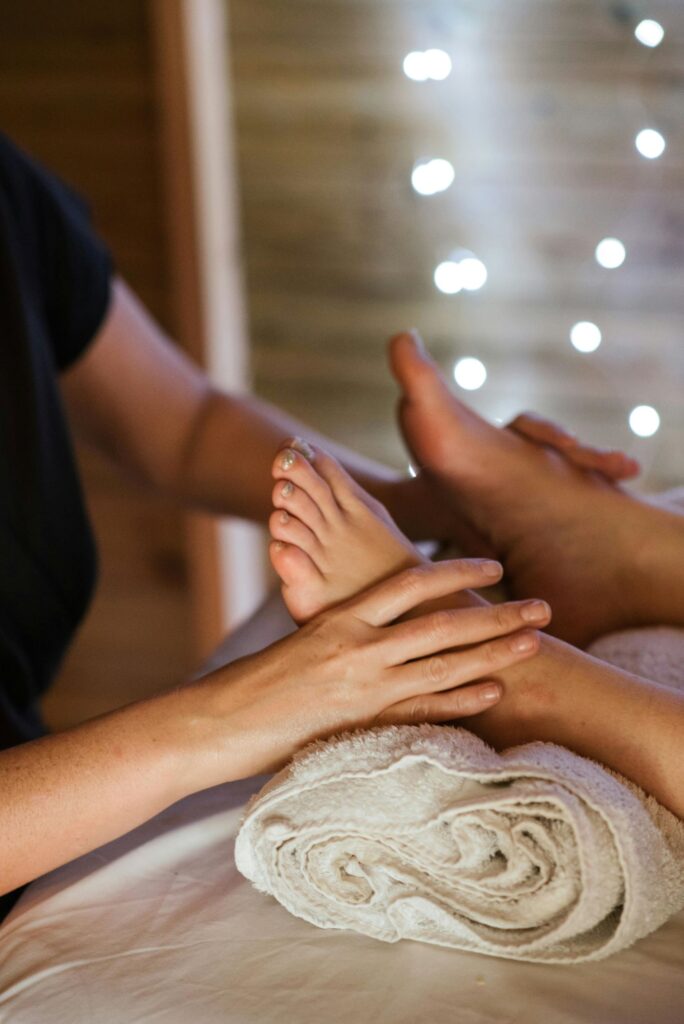Homeopathy
Discover the Miraculous World of Ayurvedic Massage!
Ayurvedic massage is a comprehensive approach that may restore both your body and mind, whether you’re a wellness fanatic or just looking for a way to unwind. This traditional therapy, which originated in ancient India, is based on the principals of Ayurveda, a natural medical system that focuses on creating internal balance and harmony.
To relax and nourish the skin, Ayurvedic massages use organic oils combined with carefully selected herbs. The therapist uses a variety of techniques, such as rhythmic strokes, mild stretching, and pressure point manipulation, to relieve tension and promote deep relaxation. This therapeutic touch not only enhances blood circulation, but it also activates the body’s natural healing mechanisms.
It strives to restore energy balance in addition to physical relaxation. It is said to balance the body’s doshas, or vital energies, which can improve overall health.
History and Origins of Ayurvedic Massage
It has a long and rich history, dating back thousands of years to ancient Indian civilization. Ayurveda, which includes a variety of treatment modalities such as massage, was established by sages and intellectuals who wanted to understand the human body and its relationship with the world.
It can be traced back to ancient Ayurvedic literature such as the Charaka Samhita and the Sushruta Samhita, which contain thorough instructions on the many techniques and oils used in massage therapy. These books also emphasize the significance of balance and harmony in promoting well health.
Over time, Ayurvedic massage has evolved and adapted to diverse cultures and areas, utilizing indigenous herbs and techniques. It is now practiced not only in India, but throughout the world, as people seek its countless benefits.
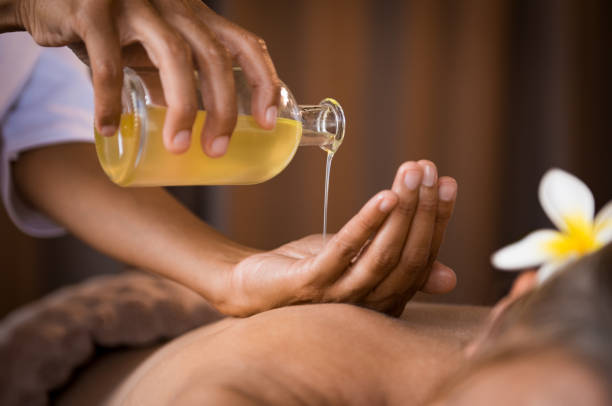
Principles of Ayurvedic Massage
Ayurvedic massage is founded on Ayurvedic concepts, which consider the body to be a microcosm of the world. According to Ayurveda, each person is made up of a distinct blend of the three doshas: Vata, Pitta, and Kapha. These doshas influence numerous areas of our physical, mental, and emotional health.
Ayurvedic massage aims to restore balance and harmony amongst the doshas, as imbalances are thought to be the core cause of sickness and discomfort. The massage techniques and oils used are selected based on the individual’s dosha constitution and any specific imbalances that may be present.
An Ayurvedic massage involves the therapist working with the body’s energy channels, known as nadis, to increase the flow of vital energy. By applying pressure to specific areas and employing specific strokes, the therapist hopes to release trapped energy and encourage a fluid flow throughout the body.
Benefits of Ayurvedic Massage
It has numerous advantages to both the body and mind. Here are some of the main benefits you can get from this old practice:
- Relaxation and stress relief: Ayurvedic massage uses gentle strokes and rhythmic motions to relax the body and quiet the mind. The release of tension and stress can lead to a deep sensation of relaxation and renewal.
- Improved blood circulation: The massage techniques employed in Ayurvedic massage aid in improving blood circulation, which can improve the delivery of oxygen and nutrients to the body’s cells. This can lead to better overall health and vigor.
- Detoxification: Ayurvedic massage stimulates the lymphatic system, which helps the body eliminate toxins. The massage, by encouraging lymphatic drainage, can assist to cleanse the body and enhance immunity.
- Relief from muscle tension and pain: Gentle stretching, pressure point manipulation, and the application of warm herbal oils can all assist to reduce muscle tension and pain. This makes Ayurvedic massage a good choice for persons with chronic muscular issues or injuries.
- Enhanced mental clarity and focus: Ayurvedic massage calms the body while simultaneously clearing the mind. Therapeutic touch and the application of particular oils can increase mental clarity, focus, and concentration.
- Improved sleep quality: Many people report sleeping deeper and more soundly after receiving an Ayurvedic massage. The relaxation caused by the massage can assist to soothe the nervous system and produce a sense of calmness, making it easier to go asleep and stay asleep all night.
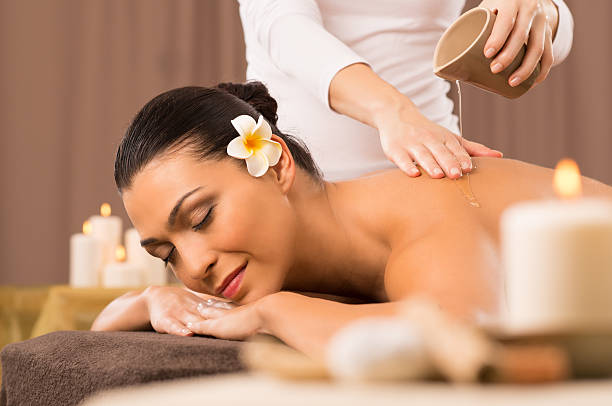
Different Types of Ayurvedic Massage Techniques
Ayurvedic massage encompasses a variety of techniques, each with its own unique benefits. Here are some of the most commonly practiced Ayurvedic massage techniques:
- Abhyanga: Abhyanga is a full-body massage that involves the application of warm herbal oils to the body. The therapist uses long, sweeping strokes to stimulate blood flow, nourish the skin, and promote relaxation.
- Shirodhara: Shirodhara is a deeply relaxing Ayurvedic therapy that involves pouring a continuous stream of warm oil onto the forehead. This technique is believed to calm the mind, relieve stress, and balance the doshas.
- Pinda Sweda: Pinda Sweda, also known as Navarakizhi, is a massage technique that uses warm herbal poultices to apply heat and pressure to specific parts of the body. This therapy is particularly beneficial for relieving joint pain, muscle stiffness, and inflammation.
- Udvartana: Udvartana is a massage technique that involves applying a paste made from herbal powders and oils to the body. The therapist uses vigorous strokes and circular movements to exfoliate the skin, improve circulation, and promote detoxification.
Ayurvedic Massage Oils and Their Benefits
The use of oils is an integral part of Ayurvedic massage, as they help to nourish and moisturize the skin, promote relaxation, and balance the doshas. Here are some commonly used Ayurvedic massage oils and their benefits:
- Sesame oil: is one of the most used oils for Ayurvedic massage. It has a warming impact on the body and is especially useful for balancing the Vata dosha. Sesame oil also has hydrating effects that can assist to relieve dry, rough skin.
- Coconut oil: is cooling in nature and is commonly used in Ayurvedic massage to balance Pitta dosha. It has a light texture and is quickly absorbed by the skin, making it ideal for persons with sensitive or oily skin.
- Almond oil: it has nourishing and revitalizing effects. It is excellent for all dosha types, but is especially beneficial for dry or aged skin. Almond oil has a relaxing impact on the mind, making it great for encouraging relaxation.
- Olive oil: is a versatile oil used in many Ayurvedic therapies, including massage. It is high in antioxidants and has moisturizing characteristics, which can help soften and hydrate the skin. Olive oil is appropriate for all dosha types.
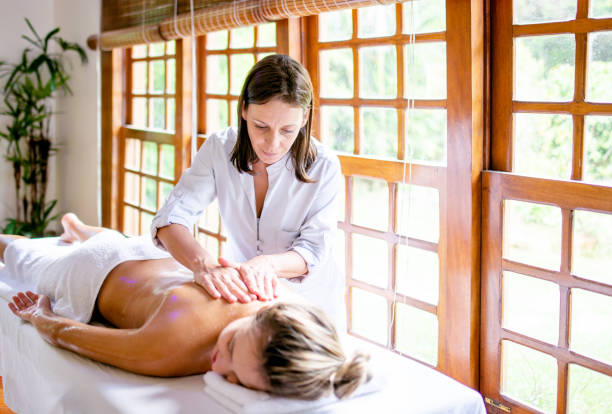
Ayurvedic Massage for Specific Health Conditions
Ayurvedic massage can be customized to address specific health conditions or imbalances in the body. Here are some examples of how Ayurvedic massage can benefit certain health conditions:
- Stress and anxiety: Ayurvedic massage is known for its relaxing and grounding properties, making it a good alternative for people experiencing stress and anxiety. The relaxation caused by the massage can assist to ease the symptoms of certain disorders and promote overall well-being.
- Muscle and joint discomfort: Gentle stretching, pressure point manipulation, and the application of warm herbal oils can all assist to relieve muscle and joint pain. Ayurvedic massage is very effective for illnesses including arthritis, fibromyalgia, and sports injuries.
- Digestive disorders: Ayurvedic massage practices, such as abdominal massage, can aid digestion and alleviate digestive issues. Therapeutic touch and the application of particular oils can aid in balancing the digestive fire and promoting healthy digestion.
- Insomnia: Because Ayurvedic massage calms the nervous system, it can help those who suffer from insomnia. Massage-induced relaxation can enhance restful sleep and increase sleep quality.
How to Prepare for an Ayurvedic Massage
To fully enjoy the benefits of an Ayurvedic massage, it is essential to prepare both your body and mind. Here are some tips to help you prepare for your massage session:
- Choose a qualified Ayurvedic massage therapist: Look for a therapist who has received proper training in Ayurvedic massage techniques and has experience working with clients. Ask for recommendations from friends or family members, or consult online directories of certified Ayurvedic practitioners.
- Communicate your needs and expectations: Before your massage, communicate any specific health concerns or areas of the body that require attention. This will help the therapist tailor the massage to your needs and ensure that you receive maximum benefit from the session.
- Avoid heavy meals before the massage: It is recommended to have a light meal at least two hours before your massage session. Avoid consuming heavy or spicy foods, as they may interfere with the digestion process during the massage.
- Drink plenty of water: Hydration is important both before and after your massage. Drinking water before the session can help to hydrate your body and prepare it for the massage. After the session, drinking water can help to flush out toxins released during the massage.
- Arrive early and relax: Arrive at least 10-15 minutes before your scheduled appointment to allow yourself time to relax and unwind. Take a few moments to sit quietly and focus on your breath to calm your mind and prepare for the massage.
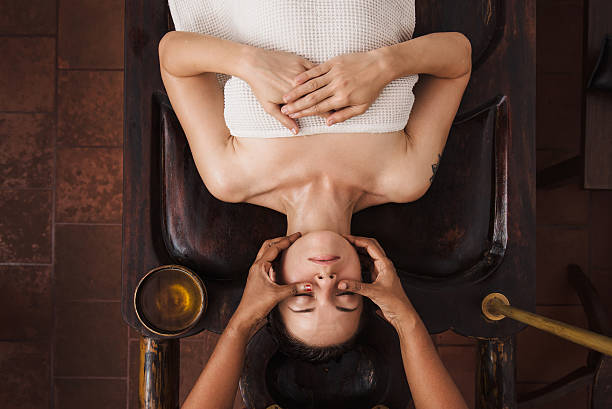
Finding a Qualified Ayurvedic Massage Therapist
Finding a qualified Ayurvedic massage therapist is crucial to ensure a safe and effective massage experience. Here are some tips to help you find a qualified practitioner:
- Research and read reviews: Do your research and read reviews of different massage therapists in your area. Look for therapists who have received positive feedback from their clients and have a good reputation for their skills and expertise.
- Check certifications and qualifications: Look for therapists who have completed formal training in Ayurvedic massage and are certified by reputable institutions. Check if they are members of professional associations related to Ayurveda and massage therapy.
- Consult with the therapist: Before booking a session, schedule a consultation with the therapist to discuss your specific needs and expectations. This will give you an opportunity to assess their knowledge and expertise and determine if they are the right fit for you.
- Ask for recommendations: Seek recommendations from friends, family members, or healthcare professionals who have had positive experiences with massage. Personal recommendations can provide valuable insights and help you find a trusted therapist.
Conclusion
It is a powerful and holistic practice that I believe offers numerous benefits for both the body and mind. It combines ancient wisdom with modern therapeutic techniques to promote relaxation, balance, and overall well-being.
Whether I’m seeking relief from stress, muscle tension, or simply want to reconnect with my body, an Ayurvedic massage, in my opinion, offers a unique and blissful experience that nurtures both my physical and mental health. By immersing myself in this ancient practice, I believe I can discover a deeper sense of balance and harmony within.
I understand the importance of choosing a qualified massage therapist, communicating my needs and expectations, and preparing my body and mind for the session. With proper preparation and a skilled therapist, I believe I can experience the transformative power of it and embark on a journey towards optimal health and wellness.
Trusted Health, Wellness, and Medical advice for your well-being

